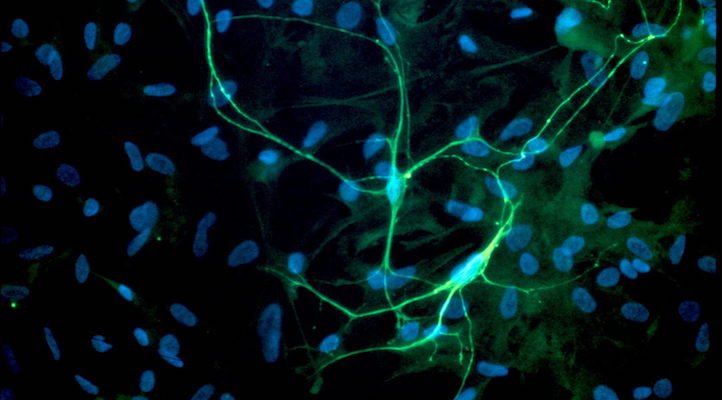The Bernstein Focus Neurotechnology (BFNT) Freiburg * Tübingen
Stroke, injuries to the brain, epilepsy, Parkinson’s disease and similar neurological syndromes seriously impair the movement and communication capacity of the patients. They reduce the quality of life and limit participation in daily life. In a considerable fraction of cases pharmacological treatment is ineffective or insufficient to alleviate the symptoms. Neurotechnology is a rapidly growing field of research, which, according to our definition, strives to treat, replace or support physical functions lost through diseases of the nervous system with technical means.
Towards this goal, electrical or chemical signals recorded in the brain are used to control external or implanted devices. Based on the analysis and interpretation of electrical signals, computers could be controlled without keyboard or mouse. Prostheses could be constructed to reinstate voluntary movement based on the activity recorded via brain-machine-interfaces (BMI). Similarly, electrical stimuli or drugs could be delivered not on a regular schedule, but depending on the need determined from brain activity, e.g. to intervene with upcoming epileptic seizures or migraine episodes. Such devices could significantly improve the quality of life of these patients, as do cochlea-implants for the deaf and deep brain stimulators for some patients with Parkinson’s disease, devices already in use. Nonetheless, extensive research is needed to improve recording and interpretation of the neuronal signals, to stabilize them for long-term implants, maximize information retrieval and use this to control devices. The electrode-to-tissue interfaces need to be optimized to minimize short- and long-term tissue damage, in particular when used to apply electrical stimuli for defined effects and efficacy.
While considerable progress has been reported in recent years, mostly with invasive electrode arrays inserted into the neocortex of monkeys in the US, devices for human usage are still in an early stage of development. Furthermore, ethical and technical aspects demand that less invasive approaches be evaluated and pursued. BMI research in Europe has mostly emphasized these techniques, such as recording with electrode grids placed on top of the cortex (electrocorticogram (ECoG) or on the skull (EEG). The former is less invasive than implanted electrodes, but more specific and yielding information EEG recordings. The approach is promising for its flexibility, not only to control motor control devices, but also to exploit brain activity in other regions, which subject can learn to control to some extent.
Research Projects and PIs:
Understanding the Principles
This cluster aims to understand principles and neuronal mechanisms of hybrid brain-machine interfaces. The goal is to identify, analyze and interpret neuronal signals to predict upcoming network states and behavioral intentions. In animal and human studies, we will compare data from multiple levels of resolution and network sizes to identify optimal information sources and intervention targets for HBMIs. Based on these we will explore direct interaction with ongoing network dynamics using neuroelectronic interfaces, addressing a major aspect of HBMIs. A second line focuses on the co-adaptivity between brain and machine in human subjects. Each of these projects will contribute to technological HBMI improvements in B and will help pave the way for innovative clinical applications in C.
- A1: Connecting brain activity across levels of resolution
C. Boucsein, A. Aertsen - A2: Voluntary control of neuronal correlations for BMIs
C. Mehring, C. Braun, H. Preissl, A. Schulze-Bonhage, A. Aertsen, A. Gharabaghi - A3: Co-Adaptivity of brain and computer: Interaction of two learning signals
C. Mehring, M. Bogdan, B. Schölkopf, A. Aertsen - A4: Adaptive interception of epileptic events based on predictive network dynamics
U. Egert - A5: Defined stimulus-response functions in active networks
U. Egert, A. Stett
Extending Technology
HBMI technology encompasses highly specialized and efficient microsystems technology and system integration. This cluster will address issues of electrode design, surface conditioning, reliability, miniaturization, packaging and software interfacing, as well as the development of the necessary advanced software tools for simulation and data analysis. These tools contribute to both lines of research undertaken in A and to the clinical application undertaken in C.
- B1: Development, prototyping, fabrication and testing of individualized and long-term safe electrode arrays
A. Stett, T. Stieglitz, J. Rühe - B2: Multielectrode arrays with adjustable stiffness
T. Stieglitz, J. Rühe - B3: Improving microelectrodes for single cell recordings in the human brain
S. Hefft, D. von Elverfeldt, I. Mader, A. Schulze-Bonhage, R. Mattmüller - B4: NEURONLINE – System for the on-site/on-line monitoring of neuronal population activity
S. Rotter - B5: NETCAD – An environment for 3D structural modeling of biological neuronal networks
S. Rotter, M. Diesmann, E. Körner - B6: IMCRSS: Implantable Multi-Channel Recording and Stimulation System
K.-H. Boven, J. Rickert
Clinical Application & Neuroethics
In this cluster, HBMIs based on the research in A and B will utilize electrical and metabolic neuronal signals to help restore motor function and communication, and to intervene with acute pathological conditions in epilepsy and migraine. These projects are vital to validate new technologies and applications, and to provide feedback. We have chosen to address several clinical conditions to broaden the basis for HBMIs and the range of applications for the technologies developed in B. Ethical implications of neurotechnical devices will be investigated to anticipate their impact on individual and society, and to incorporate these considerations into the technological developments.
- C1: Motor restoration with brain-machine interface systems in chronic stroke
N. Birbaumer, S. Soekadar, C. Weiller - C2: Direct brain communication, neuroprostheses and brain implants in paralysis
A. Gharabaghi, M. Tatagiba, N. Birbaumer, C. Mehring - C3: Regulation of metabolic brain function and brain connectivity: application and model systems
N. Birbaumer, U. Strehl, K. Ugurbil, T. Ball, J. Hennig - C4: Real time metabolite sensing for feedback control of behaviour in neurological disorders
G. Urban, C. Weiller - C5: Multicontact stimulation techniques for interventions in human focal epilepsy
A. Schulze-Bonhage, T. Stieglitz, R. Mattmüller - C6: Neuroethics & Neurotechnology: Emerging questions from hybrid brains
O. Müller, G. Maio


